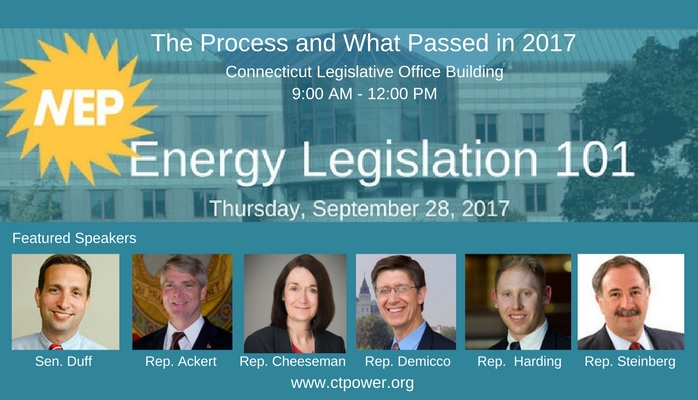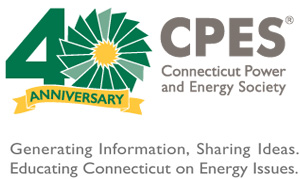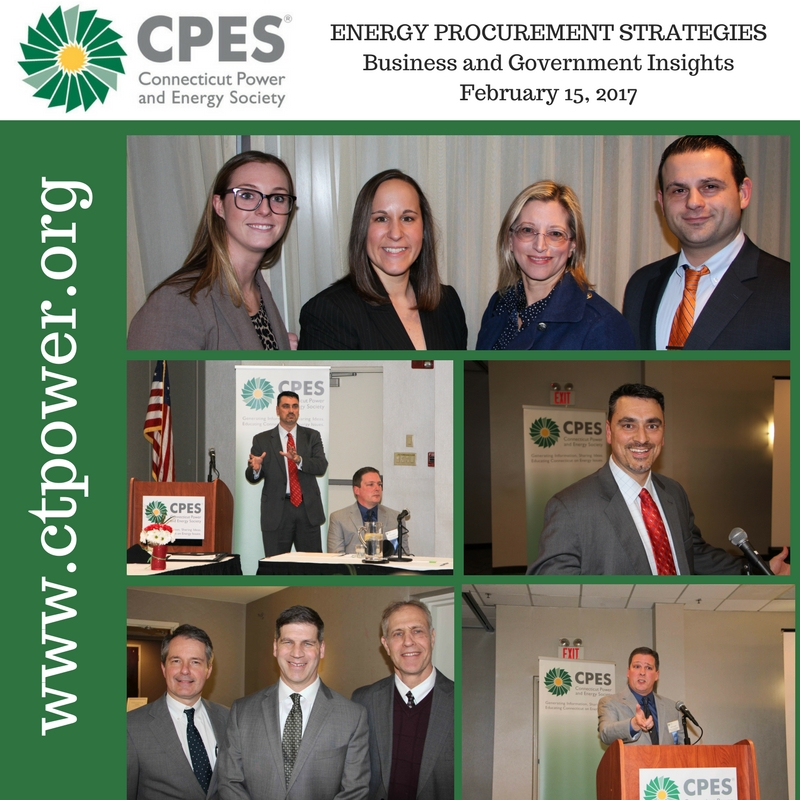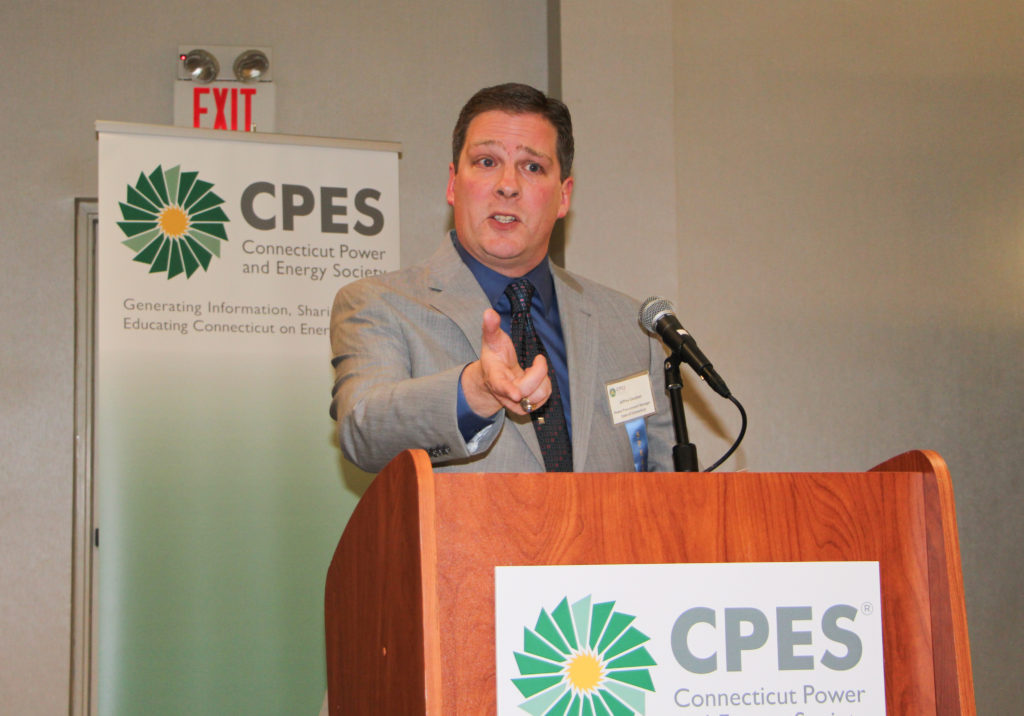
Half Day Event, 9am – Noon
Connecticut Legislative Office Building
Thursday, September 28, 2017
Lobbying 101 Presentation
Wrap Up:
CPES Holds Second 101 Series Event for New Energy Professionals!
On September 28, 2017, the Connecticut Power and Energy Society’s New Energy Professionals Committee hosted “Energy Legislation 101: The Process and What Passed in 2017” at the Legislative Office Building and State Capitol in Hartford, Connecticut. Energy Legislation 101 is the second in a series of informational sessions established to assist recently joined CPES members and those new to the industry as they become acclimated and involved within the organization. The overarching goal of the 101 series is to provide a meaningful overview of state agencies and businesses with whom professionals in the industry interact. While the event was geared toward New Energy Professionals, many established professionals were also in attendance.
The day began with an overview of the legislative process in Connecticut from Melissa Biggs, a partner at DePino, Nunez & Biggs, LLC, and Christopher Cordima, an attorney in the Connecticut Legislative Commissioners’ Office.
The overview was followed by a timely discussion of energy legislation that passed during the 2017 legislative session and what issues may arise next session. Joining the conversation were Senator Bob Duff, Representative Tim Ackert, Representative Holly Cheeseman, Representative Mike Demicco, Representative Stephen Harding, and Representative Jonathan Steinberg. All serve on the General Assembly’s Energy & Technology Committee, Environment Committee, or both!
The day ended with a tour of the Legislative Office Building and State Capitol.
Blurb:
Please join us as Connecticut’s key energy and environment legislative staff and leaders offer a three-part Energy Legislation 101 to CPES New Energy Professionals*! Come brush up on all the details of the legislative process. Continue into a timely discussion of the bills which become effective as of October 1st. Finish with a tour of the Legislative Office Building and Capitol.

This is a free event, but please register at your earliest convenience as space is limited.
Agenda:
9:00am – Networking, Coffee and Danish
(Second Floor Atrium of the Legislative Office Building)
9:30am – Energy Legislation 101: Basics and Procedures (Hearing Room 2E)
Melissa Biggs, DePino, Nunez & Biggs, LLC
Christopher Cordima, CT Legislative Commissioners’ Office
10:00am – Current and Future Legislation Discussion: A detailed and timely conversation about the energy bills that just passed and become effective as of October 1st. (Hearing Room 2E)
11:15am: (Optional) The League of Women Voters is offering a tour of the Legislative Office Building and Capitol
*This group is not limited to age range or years of experience. We welcome everyone to reach out to us.
The goal of the 101 series is to provide a meaningful overview of state agencies and businesses with whom professionals in our industry interact. While this series was established with our New Energy Professionals in mind, all are welcome.” – Alex Isaac, NEP Group Member


 Jeffrey Gaudiosi opened the discussion with a look back at how energy was procured in the state of Connecticut after the electricity market deregulated in 1998. Deregulation allowed retail customers to choose a competitive supplier of electricity, but required the state’s electric distribution companies to continue to provide “Standard Service” and “Supplier of Last Resort Service” to customers who did not choose a competitive supplier. He explained that the legislature dictated how electricity was procured for these customers, requiring the utilities to employ a three-year laddering model for Standard Service power procurements. This procurement method involved a series of overlapping wholesale contracts extending over several years, which kept retail electricity prices relatively stable for consumers. This method worked well for many years, Gaudiosi explained, but fell out of favor when Standard Service rates reached record levels and prevented retail customers from taking advantage of declining wholesale electricity prices in the 2009-2010 timeframe.
Jeffrey Gaudiosi opened the discussion with a look back at how energy was procured in the state of Connecticut after the electricity market deregulated in 1998. Deregulation allowed retail customers to choose a competitive supplier of electricity, but required the state’s electric distribution companies to continue to provide “Standard Service” and “Supplier of Last Resort Service” to customers who did not choose a competitive supplier. He explained that the legislature dictated how electricity was procured for these customers, requiring the utilities to employ a three-year laddering model for Standard Service power procurements. This procurement method involved a series of overlapping wholesale contracts extending over several years, which kept retail electricity prices relatively stable for consumers. This method worked well for many years, Gaudiosi explained, but fell out of favor when Standard Service rates reached record levels and prevented retail customers from taking advantage of declining wholesale electricity prices in the 2009-2010 timeframe. David Ferro rounded out the discussion with a look at how consultants and brokers are changing their power procurement strategies based on what is happening in the marketplace. He highlighted natural gas storage volumes as one of the primary drivers of wholesale electricity prices in the U.S. In New England, he pointed to increasing capacity and transmission costs impacting wholesale electricity prices, and discussed the significant turnover in the generation fleet away from coal- and oil-fired generation toward natural-gas fired generation. This, he said, will put additional pressure on the natural gas infrastructure serving the region, which can have a significant impact on wholesale electricity prices. He concluded with a list of seven steps for developing an energy supply strategy – for facility managers, supply chain professionals, and those involved in managing energy procurement strategies. Technology advancements, he said, will be extremely important in creating a “sustainable energy community” where consumers have more control over their energy supply.
David Ferro rounded out the discussion with a look at how consultants and brokers are changing their power procurement strategies based on what is happening in the marketplace. He highlighted natural gas storage volumes as one of the primary drivers of wholesale electricity prices in the U.S. In New England, he pointed to increasing capacity and transmission costs impacting wholesale electricity prices, and discussed the significant turnover in the generation fleet away from coal- and oil-fired generation toward natural-gas fired generation. This, he said, will put additional pressure on the natural gas infrastructure serving the region, which can have a significant impact on wholesale electricity prices. He concluded with a list of seven steps for developing an energy supply strategy – for facility managers, supply chain professionals, and those involved in managing energy procurement strategies. Technology advancements, he said, will be extremely important in creating a “sustainable energy community” where consumers have more control over their energy supply. 

